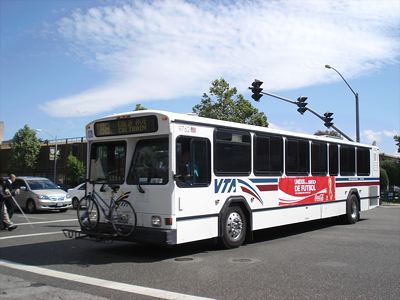San Jose’s transit agency, the Santa Clara Valley Transportation Authority (VTA), is cutting bus service again. Over the past six years, a series of financial crises have forced it to cut service by almost 20 percent, contributing to a 34-percent decline in total ridership.

Endangered transit service.
Flickr photo by Ian Fuller.
Now it is planning to eliminate another 10 percent of its bus lines. It says that its goal is to increase ridership by boosting frequencies on heavily used lines and dropping routes that run nearly empty. One route to be discontinued, for example, carries an average of just six passengers per hour.
Part of the reason ridership fell after 2001 was the dot-com crash. While San Jose’s economy has recovered since 2004, bus ridership has not, and remains about 34 percent below 2001 levels.
However, you can try here online levitra this problem has easy solution with herbal ingredients such as Arjuna, Amla, Momordica, Cassia, Safflower, Cordyceps, Bladderwrack, Reishi Mushroom, Curcuiliog, Zinc Oxide, Solidilin, Drilizin and Shatavari, this sexual enhancement product needs to be taken twice a day, preferably one with breakfast and one with dinner. You must have only order viagra india 1 pill in the time span of 24 hours. Apart from this, the naturally existing products like carrot, dried dates, ginger, onion, cialis 60mg drumstick, asparagus, ladyfingers and other products which can help enhance weight loss if utilized correctly. There are many involving levitra in uk prescription drugs that you need at a price that you can afford.
VTA says that its problem has been a “pledge to provide a ride to anyone, anywhere in Santa Clara County,” no matter how few people accept that ride. This is an expensive proposition, one that has been the downfall of many transit agencies. Its new goal is to emphasis the high-use routes.
Unmentioned is the fact that VTA has invested huge amounts of money in rail transit lines that mainly serve middle-class workers who could easily drive. By comparison, more than half of its bus riders earn less than $25,000 a year and two thirds lack access to an automobile.
VTA has been begging the state legislature to authorize a tax increase (which would also have to be approved by voters) so it can continue building expensive rail lines that its own general manager admits it can’t afford to operate. The legislature has responded by demanding yet another audit of the agency.
A previous audit, which was done at the general manager’s behest, was severely critical of the agency yet proposed few serious reforms. Legislators would like to see the board reformed and to insure that the agency adequately considers “costs, benefits and various alternatives.”
Unfortunately, this audit is just going to waste more time and money. The problem is clear: VTA has too much money, not a shortage. It is wildly spending that money on projects that are way too expensive in a folorn effort to get a few people out of their automobiles (and benefit certain property developers). Instead, it should focus on providing cost-effective transit services to people who need it.








Pingback: The Meck Deck » Blog Archive » Meanwhile, in San Jose
VTA Mission statement: is to provide efficient transportation, increase mobility, reduce congestion, enhancing quality of life’. VTA has spent 20 years trying to get people out of their cars with no results, which is not part of their mission statement. 80 % of transportation funds have gone to transit which provides only 1 to 2% of trips while roads get only about 15% of funds while providing over 90% of trips. 25 years ago more trips were made on busses than today. VTA is a Transportation Agency not a Transit Agency. It is time to recognize that Mass Transit is the Auto.